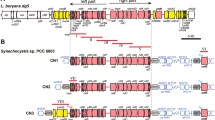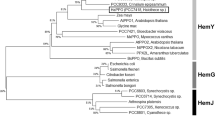Abstract
A gene, zam (for resistance to acetazolamide), controlling resistance to the carbonic anhydrase inhibitor acetazolamide, is described. It has been cloned from a spontaneous mutant, AZAr-5b, isolated from the cyanobacterium Synechocystis PCC 6803, for its resistance to this drug (Bédu et al., Plant Physiol 93: 1312–1315, 1990). This mutant, besides its resistance to acetazolamide, displayed an absence of catalysed oxygen exchange activity on whole cells, suggestive of a deficiency in carbonic anhydrase activity. The gene was isolated by screening a genomic library of AZAr-5b, and selecting for the capacity to transfer the AZAr phenotype to wild-type cells. A system leading to forced homologous recombination in the host chromosome, using a platform vector, was devised in order to bypass direct selection difficulties. The putative encoded protein, 782 amino acids long, showed some homology with four eukaryotic and prokaryotic proteins involved in different cellular processes, one of them suppressing a phosphatase deficiency. The mutated allele of AZAr-5b showed an in-frame 12 nucleotide duplication, which should not interfere with translation, and might result from transposition of a mobile element. Integration into a wild-type genome of either the spontaneous mutated allele or one inactivated by insertional mutagenesis conferred the character of resistance, but not the deficiency in oxygen exchange, indicating that the two phenotypic aspects of AZAr-5b corresponded to two independent mutations. A working hypothesis explaining the phenotypes of the mutants is that the presence of the Zam protein would be necessary for the inhibitor to reach (one of) the two carbonic anhydrases present in this strain. This, however, would be a secondary action, the physiological role of the protein still being cryptic.
Similar content being viewed by others
References
Aizawa K, Miyachi S: Carbonic anhydrase and CO2 concentrating mechanisms in microalgae and cyanobacteria. FEMS Microbiol Rev 39: 215–233 (1986).
Bédu S, Beuf L, Joset F: Membraneous and soluble carbonic anhydrase activities in a cyanobacterium, Synechocystis PCC 6803. In: Murata N (ed) Research in Photosynthesis. vol. 3, pp. 819–822. Kluwer Academic Publishers, Dordrecht (1992).
Bédu S, Joset F: Studies on the carbonic anhydrase activity in Synechocystis PCC 6803 wild-type and an acetazolamide-resistant mutant. Can J Bot 69: 1103–1108 (1991).
Bédu S, Peltier G, Joset F: Correlation between carbonic anhydrase activity and inorganic carbon internal pool in strain Synechocystis PCC 6714. Plant Physiol 90: 470–474 (1989).
Bédu S, Sarrey F, Peltier G, Joset F: Properties of a mutant from Synechocystis PCC 6803 resistant to acetazolamide, an inhibitor of carbonic anhydrase. Plant Physiol 93: 1312–1315 (1990).
Espie GS, Miller AG, Canvin DT: Selective and reversible inhibition of active CO2 transport by hydrogen sulfide in cyanobacterium. Plant Physiol 91: 387–394 (1989).
Fukuzawa H, Suzuki E, Komukai Y, Miyachi S: A gene homologous to chloroplast carbonic anhydrase (icfA) is essential to photosynthetic carbon dioxide fixation by Synechocystis PCC 7942. Proc Natl Acad Sci USA 89: 4437–4441 (1992).
Joset F, Buchou T, Zhang C-C, Jeanjean R: Physiological and genetic analysis of the glucose-fructose permeation system in two Synechocystis species. Arch Microbiol 149: 417–421 (1988).
Kinoshita N, Geobl M, Yanagida M: The fission yeast dis3 + gene encodes a 110-kDa essential protein implicated in mitotic control. Mol Cell Biol 11: 5839–5847 (1991).
Kyte J, Doolittle RF: A simple method for displaying the hydropathic character of a protein. J Mol Biol 157: 105–132 (1982).
Mazel D, Bernard C, Schwarz R, Castets A-M, Houmard J, Tandeau de Marsac N: Characterization of two insertion sequences, IS701 and IS702, from the cyanobacterium Calothrix PCC 7601. Mol Microbiol 5: 2165–2170 (1991).
Onana B, Jeanjean R, Joset F: Gene stpA involved in the establishment of salt tolerance in the cyanobacterium Synechocystis PCC 6803. Russian Plant Physiol 41: 152–159 (1994).
Prentki P, Krish HM: In vitro insertional mutagenesis with a selectable DNA fragment. Gene 29: 303–313 (1984).
Price GD, Badger MR: Ethoxyzolamide inhibition of CO2 uptake in the cyanobacterium Synechococcus PCC 7942 without apparent inhibition of internal carbonic anhydrase activity. Plant Physiol 89: 37–43 (1989).
Price GD, Badger MR: Expression of human carbonic anhydrase in the cyanobacterium Synechococcus PCC 7942 creates a high CO2-requiring phenotype. Plant Physiol 91: 505–513 (1989).
Price G, Coleman JR, Badger MR: Association of carbonic anhydrase activity with carboxysomes isolated from the cyanobacterium Synechococcus PCC 7942. Plant Physiol 100: 784–793 (1992).
Pridmore RD: New and versatile cloning vectors with kanamycin-resistance marker. Gene 50: 309–312 (1987).
Reinhold L, Volokita M, Zenvirth D, Kaplan A: Inorganic carbon fluxes and photosynthesis in cyanobacteria: a quantitative model. In: Biggins J (ed) Progress in Photosynthesis Research, vol. 4, pp. 289–296. Martinus Nijhoff, Dordrecht (1987).
Rippka R, Deruelles J, Waterbury JB, Herdman M, Stanier RY: Generic assignments, strain histories and properties of pure cultures of cyanobacteria. J Gen Microbiol 111: 1–61 (1979).
Sambrook J, Fritsch EF, Maniatis T: Molecular Cloning: A Laboratory Manual, 2nd ed. Cold Spring Harbor Laboratory Press, Cold Spring Harbor, NY (1989).
Sanger F, Nicklen S, Coulson AR: DNA sequencing with chain-terminating inhibitors. Proc Natl Acad Sci USA 74: 5463–5467 (1977).
Scanlan DJ, Bloye SA, Mann NH, Hodgson DA, Carr NG: Construction of lacZ promoter probe vector for use in Synechococcus: application to the identification of CO2 regulated promoters. Gene 90: 43–49 (1990).
Sutton A, Immanuel D, Arndt K: The SIT4 protein phosphatase functions in late G1 for progression into S phase. Mol Cell Biol 11: 2133–2148 (1991).
Tandeau de Marsac N, Houmard J: Advances in cyanobacterial molecular genetics. In: Fay P, vanBaalen C (eds) The Cyanobacteria, pp. 251–302. Elsevier, Amsterdam (1987).
Tashian RE: Genetics of the mammalian carbonic anhydrases. Adv Genet 30: 321–356 (1992).
Tobe T, Sasakawa C, Okada N, Honma Y, Yoshikawa M: vacB, a novel chromosomal gene required for expression of virulence genes on the large plasmid of Shigella flexneri. J Bact 174: 6359–6367 (1992).
Turcq B, Dobinson KF, Serizawa N, Lambowitz AM: A protein required for RNA processing and splicing in Neurospora mitochondria is related to gene products involved in cell cycle protein phosphatase functions. Proc Natl Acad Sci USA 89: 1676–1680 (1992).
Vieira J, Messing J: The pUC plasmids, an M13mp7-derived system for insertion mutagenesis and sequencing with synthetic universal primers. Gene 19: 259–268 (1982).
Volokita M, Zenvirth D, Kaplan A, Reinhold L: Nature of the inorganic carbon species actively taken up by the cyanobacterium Anabaena variabilis. Plant Physiol 76: 599–602 (1984).
Wilson RB, Brenner AA, White TB, Engler MJ, Gaughran JP, Tatchell K: The Saccharomyces cerevisiae SRK1 gene, a suppressor for bcyl and insl, may be involved in protein phosphatase function. Mol Cell Biol 11: 3369–3373 (1991).
Yanisch-Perron C, Vieira J, Messing J: Improved M13 phage cloning vectors and host strains: nucleotide sequences of the M13mp18 and pUC19 vectors. Gene 33: 103–119 (1985).
Yu JW, Price GD, Song L, Badger MR: Isolation of a putative carboxysomal carbonic anhydrase gene from the cyanobacterium Synechococcus PCC 7942. Plant Physiol 100: 794–800 (1992).
Zhang C-C, Durand M-C, Jeanjean R, Joset F: Molecular and genetic analysis of the glucose-fructose transport system in the cyanobacterium Synechocystis PCC 6803. Mol Microbiol 3: 1221–1229 (1989).
Author information
Authors and Affiliations
Rights and permissions
About this article
Cite this article
Beuf, L., Bédu, S., Cami, B. et al. A protein is involved in accessibility of the inhibitor acetazolamide to the carbonic anhydrase(s) in the cyanobacterium Synechocystis PCC 6803. Plant Mol Biol 27, 779–788 (1995). https://doi.org/10.1007/BF00020230
Received:
Accepted:
Issue Date:
DOI: https://doi.org/10.1007/BF00020230




